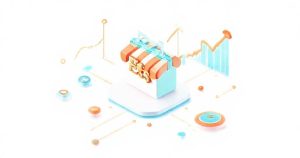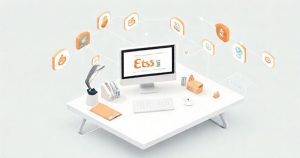Discover how the right Etsy integrations can transform your creative hobby into a streamlined, automated business. This guide explores the essential tools that connect with your Etsy shop to manage everything from product creation and marketing to accounting and shipping. By leveraging these powerful connections, you can save valuable time, reduce manual errors, and focus on what truly matters: growing your brand and creating amazing products for your customers.
Why Etsy Integrations Are a Game Changer for Your Business
For many Etsy sellers, the journey begins with a passion for creating. However, scaling a successful shop involves much more than just making products. It requires managing inventory, marketing on social media, handling finances, and processing orders. This is where Etsy integrations become indispensable. These third-party applications connect directly to your shop’s backend, creating a seamless flow of information and automating repetitive tasks that would otherwise consume your day.
Think of Etsy integrations as a team of virtual assistants working for you around the clock. Instead of manually updating your bookkeeping software after every sale, an accounting integration does it automatically. Instead of copying and pasting customer details for shipping labels, a logistics tool pulls the data instantly. This level of automation not only boosts efficiency but also enhances accuracy, minimizing the risk of human error and improving the overall customer experience. By building a connected ecosystem, you unlock the potential to scale your operations without scaling your workload.
Key Integration Categories to Supercharge Your Etsy Shop
Navigating the world of available tools can be overwhelming. To simplify the process, it’s best to focus on the core areas of your business that can benefit most from automation. These categories represent the most common challenges faced by Etsy sellers and offer the most significant returns on investment in terms of time saved and efficiency gained. Understanding these will help you build a powerful, customized tech stack for your shop.
Print on Demand (POD) Integrations for Hands Off Fulfillment
Print on Demand has revolutionized how artists and designers sell their work on Etsy. Integrations with platforms like Printful or Printify allow you to list virtual products in your shop—such as t-shirts, mugs, or posters—without holding any physical inventory. When a customer places an order, the information is automatically sent to your POD partner. They then print, pack, and ship the product directly to your customer under your brand name.
This model eliminates the financial risk of buying stock upfront and frees you from the complexities of fulfillment. For example, a graphic designer can sell a single t-shirt design in dozens of sizes and colors without ever touching a garment. The profitability lies in the margin between your Etsy list price and the POD provider’s base cost. This is one of the most powerful Etsy integrations for creative entrepreneurs looking to scale effortlessly.
Marketing and Social Media Automation Tools
Consistent marketing is crucial for driving traffic to your Etsy shop, but it can be incredibly time-consuming. Marketing integrations help automate this process. For instance, tools can automatically share your new Etsy listings on Pinterest, Instagram, or Facebook, ensuring your followers are always aware of your latest products. This keeps your social media channels active without requiring you to post manually every day.
Email marketing integrations, such as those for Mailchimp or AWeber, are also vital. These tools help you build a customer email list, allowing you to communicate directly with your audience about sales, new collections, and shop updates. Automating follow-up emails or sending out a monthly newsletter becomes simple, helping you build customer loyalty and encourage repeat purchases—a key driver of long-term success on the platform.
Accounting and Finance Software for Seamless Bookkeeping
Keeping track of income, expenses, fees, and taxes is a critical but often tedious part of running an Etsy shop. Accounting integrations, like those for QuickBooks or GoDaddy Bookkeeping, are designed to solve this problem. They sync directly with your Etsy account, automatically importing all sales and fee data in real time. This eliminates the need for manual data entry and ensures your financial records are always accurate and up to date.
These Etsy integrations make tax time significantly less stressful. They can categorize your expenses, calculate your estimated tax liability, and generate profit and loss statements with a few clicks. For sellers who want a clear, ongoing picture of their shop’s financial health, an accounting integration is not just a convenience—it’s an essential tool for making informed business decisions and maintaining compliance.
Choosing the Right Integration: A Strategic Approach
Not all Etsy integrations are created equal, and the best tool for one shop may not be right for another. When selecting an integration, consider several key factors. First, evaluate the cost versus the value. While some tools are free, many operate on a subscription model. Calculate the amount of time you expect to save and determine if the monthly fee provides a positive return on investment. Often, reclaiming just a few hours a month justifies the cost.
Second, look for ease of use and reliable customer support. The purpose of an integration is to simplify your workflow, not complicate it. Choose tools with an intuitive interface and positive user reviews. Finally, consider scalability. Select integrations that can grow with your business. A tool that works well for 10 orders a month should also be able to handle 100 or 1,000 without issue. A strategic choice today will prevent operational headaches tomorrow.
Etsy Integrations vs. Standalone Tools: A Profitability Analysis
A common question for sellers is whether to use a dedicated Etsy integration or a separate, non-integrated tool. While a standalone spreadsheet might seem cheaper for bookkeeping, the hidden cost is your time. If you spend five hours a month manually reconciling sales data, that is five hours you are not spending on product development, marketing, or customer service—activities that directly generate revenue.
Let’s consider an example. A social media scheduling tool that integrates with Etsy might cost $15 per month. A seller could manually post to their social channels for free. However, the integration automatically creates engaging posts from new listings, saving the seller an estimated 30 minutes per day. Over a month, that is 15 hours saved. If the seller values their time at even $10 per hour, the integration provides $150 in value for a $15 cost. This demonstrates how Etsy integrations are not just expenses; they are investments in profitability and efficiency.
The Unseen Advantage of a Connected Etsy Ecosystem
Ultimately, the true power of Etsy integrations lies in creating a cohesive business ecosystem where each part communicates seamlessly with the others. When your POD service, marketing platform, and accounting software all work in harmony with your Etsy shop, you build a resilient and scalable operation. This frees you from the mundane administrative tasks and allows you to rediscover the creative passion that inspired you to start your Etsy journey in the first place. A well-integrated shop is not just more efficient; it is a stronger, more sustainable business poised for future growth.






